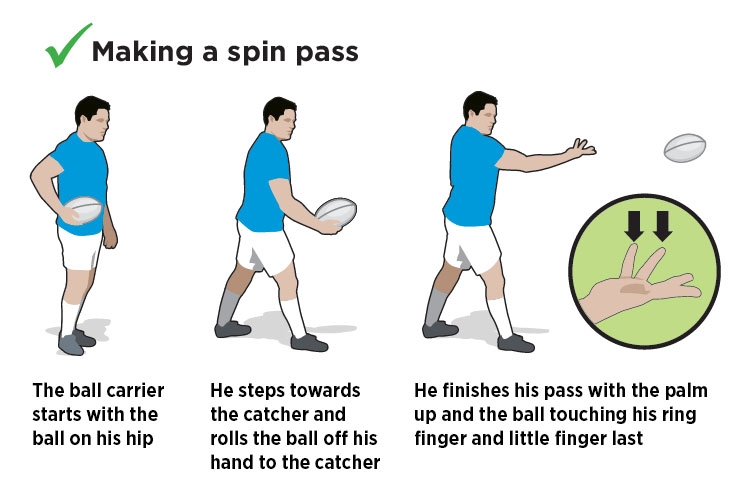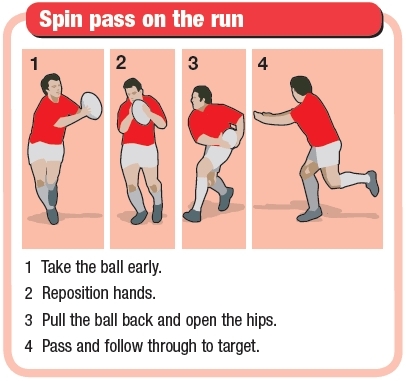Throwing a rugby ball might seem tricky. But with practice, anyone can do it.
Rugby is a sport that requires skill and precision, especially when it comes to passing the ball. A well-thrown ball can make the difference between winning and losing. It’s important to learn the correct techniques. This ensures that the ball travels accurately and quickly to your teammate.
Whether you’re a beginner or looking to improve your game, understanding the basics of throwing a rugby ball is essential. In this guide, we will break down the steps. You’ll learn how to hold, aim, and throw the ball effectively. Let’s get started and make your throws count on the rugby field.
Introduction To Rugby Ball Throwing
Rugby is a thrilling sport, and throwing the ball is a key skill. Understanding how to throw a rugby ball properly can improve your game. This guide will help you learn the basics and avoid common mistakes.
Importance Of Technique
Good technique is crucial for an effective throw. Proper technique ensures the ball travels accurately and with speed.
Here are some key points to remember:
- Grip the ball with both hands, fingers spread.
- Stand with your feet shoulder-width apart.
- Keep your elbows slightly bent and relaxed.
- Rotate your torso as you throw for added power.
Common Mistakes
Many beginners make similar errors when learning to throw a rugby ball.
Avoid these common mistakes to improve your throw:
- Incorrect Grip: Holding the ball too tightly reduces control.
- Stiff Arms: Keeping your arms stiff limits your range of motion.
- Poor Stance: Standing too narrow or too wide affects balance.
- Lack of Follow-Through: Not following through reduces accuracy.
Focus on these tips to enhance your rugby ball throwing skills. Practice regularly to develop muscle memory and confidence.
Choosing The Right Rugby Ball
Choosing the right rugby ball is crucial for a great game. A good rugby ball can improve your performance and enjoyment. It is important to select a ball that fits your needs.
Size And Weight
Rugby balls come in different sizes. Choose the size based on your age and level. For kids, smaller sizes work best. Adults should use standard size balls. The weight of the ball also matters. Lighter balls are easier to throw. Heavier balls are better for serious practice.
Grip And Material
The grip of the ball affects how well you can hold it. A ball with good grip is easier to control. Look for balls with textured surfaces. The material of the ball should be durable. Synthetic rubber is a common choice. It offers good grip and lasts longer. Natural leather balls are also available. They are more traditional but need more care.
Basic Hand Positioning
Learning to throw a rugby ball begins with mastering basic hand positioning. Proper hand placement ensures accurate and powerful throws. This section covers the essential aspects of positioning your hands correctly.
Dominant Hand Placement
Your dominant hand plays a key role in controlling the ball’s direction and speed. Place your dominant hand at the back of the ball. Your fingers should spread evenly around the ball, with your thumb resting underneath. This grip provides stability and control.
Ensure your palm is not too tight against the ball. A relaxed grip helps in making smooth and accurate passes. Practice gripping the ball until it feels natural.
Supporting Hand Role
The supporting hand guides the ball and assists in the throw. Place your non-dominant hand near the front of the ball. This hand should not grip tightly but should help in aiming and steadying the ball.
Keep the fingers of your supporting hand spread out. This provides additional balance and control. Your supporting hand works in tandem with your dominant hand to ensure a smooth throw.
| Hand | Position | Function |
|---|---|---|
| Dominant Hand | Back of the ball | Control and direction |
| Supporting Hand | Front of the ball | Guidance and balance |
Remember, consistency in hand positioning is crucial. Regular practice helps in developing muscle memory. This leads to more accurate and powerful throws over time.
- Place dominant hand at the back of the ball
- Spread fingers evenly
- Keep thumb underneath
- Use relaxed grip
- Place supporting hand near the front
- Spread fingers for balance
Follow these tips to perfect your hand positioning. They are fundamental for improving your rugby throw.

Credit: www.rugbycoachweekly.net
Body Stance And Alignment
To throw a rugby ball effectively, body stance and alignment are crucial. Proper stance ensures balance and power. Good alignment helps with accuracy and distance. This section will guide you through the essential components.
Feet Position
Your feet should be shoulder-width apart. This gives you a stable base. Keep your weight balanced on the balls of your feet. Point your lead foot in the direction of the throw. This aids in guiding the ball. Your back foot should be slightly behind you. This helps with balance and power.
Torso And Shoulders
Keep your torso upright but relaxed. This allows for better movement. Turn your shoulders slightly towards the target. This aligns your body with the throw. Your throwing shoulder should be back. This prepares you for the throw. The non-throwing shoulder should be pointed towards your target. This helps with aim and control.
Throwing Mechanics
Understanding the mechanics of throwing a rugby ball is crucial for accuracy and power. Good technique ensures the ball reaches its target effectively. By focusing on the wind-up motion and follow through, you can improve your throwing skills.
Wind-up Motion
The wind-up motion sets the stage for a powerful throw. Start with the ball in both hands. Hold it at chest level. Keep your elbows bent. Position your feet shoulder-width apart. Point your non-dominant shoulder towards your target.
Rotate your torso slightly away from the target. This rotation helps build momentum. Shift your weight to your back foot. Your dominant hand should grip the ball firmly. The non-dominant hand supports the ball. This ensures control during the throw.
Follow Through
The follow through is as important as the wind-up. Begin by uncoiling your torso. Shift your weight from your back foot to your front foot. This transfer of weight adds power to your throw. Extend your throwing arm towards the target.
Release the ball with a flick of the wrist. This flick creates a spiral motion. A spiral ensures the ball travels straight and far. Your non-dominant hand should guide the ball. Finish with your throwing hand pointing at the target. This helps with accuracy.
Practice these mechanics regularly. Consistency is key. With time, your throws will become more precise and powerful.
Advanced Throwing Techniques
Learning to throw a rugby ball is essential for any player. Basic throws are good for beginners. But, advanced techniques can elevate your game. In this section, we explore two advanced throws: the Spin Pass and the Pop Pass.
Spin Pass
The Spin Pass is vital for long-distance throws. It involves a spinning motion. This technique ensures the ball travels fast and straight. Hold the ball with both hands. Position your fingers along the seams. Rotate your wrists as you release the ball. This rotation creates the spin.
Make sure to follow through with your arms. Aim for your teammate’s chest. Practice will improve your accuracy and speed. The Spin Pass is great for quick plays and long passes.
Pop Pass
The Pop Pass is useful for short, quick throws. It is often used in close quarters. Hold the ball with both hands. Keep your elbows close to your body. Push the ball forward with a slight upward motion. The ball should travel a short distance.
Accuracy is key with the Pop Pass. Aim for your teammate’s hands. This pass is excellent for getting the ball out quickly. It is often used to evade defenders. Practice will help you perfect the Pop Pass.
Drills To Improve Accuracy
Improving accuracy in throwing a rugby ball is essential for the game. Various drills can help enhance this skill. Practicing regularly will lead to better performance on the field. Let’s explore two effective drills to improve accuracy.
Wall Passing
Find a solid wall to practice against. Stand about five meters away. Throw the ball at a marked spot on the wall. Aim for the same spot each time. Use both hands to throw. Repeat this drill for 10-15 minutes daily. This helps improve your aim and strength.
Target Practice
Set up targets at different distances. Use cones or any markers. Stand at a fixed point and throw the ball at the targets. Start with closer targets and move to farther ones. Practice hitting the targets with accuracy. Repeat this drill multiple times. This helps enhance precision and control.

Credit: www.rugbycoachweekly.net
Common Challenges And Solutions
Throwing a rugby ball requires mastering grip and technique. Many struggle with achieving a spiral throw. Regular practice and proper hand placement can improve accuracy and distance.
Throwing a rugby ball may seem simple, but many face challenges. These issues can affect your performance and confidence. Identifying common problems and their solutions helps improve your game.Grip Issues
Many struggle with the correct grip. A poor grip affects your throw’s accuracy and distance. Ensure your fingers are spread across the seams. Your thumb should be on one side, with your fingers on the other. Practice holding the ball this way. A proper grip ensures better control. It also helps with a smooth release. If your hands are small, use a smaller ball for practice. This helps you get used to the right grip.Inconsistent Throws
Inconsistent throws can be frustrating. Often, this happens due to poor technique. Focus on your stance and follow-through. Stand with your feet shoulder-width apart. Keep your body relaxed but ready. When you throw, follow through with your arm. Your hand should point where you want the ball to go. Practice this motion repeatedly. Consistency comes with repetition. Also, watch experienced players. Notice their technique and try to mimic it. “`Conclusion And Practice Tips
The art of throwing a rugby ball is not perfected overnight. It requires consistent practice, patience, and a willingness to learn. By following these tips, you can enhance your skills and enjoy the game even more. Here’s how to practice effectively and improve over time.
Regular Practice Importance
Consistency is key in rugby. Practicing regularly helps build muscle memory. This makes each throw more natural and accurate. Aim to practice at least three times a week.
Short, frequent sessions are better than long, irregular ones. This keeps your skills sharp and your body in tune. Find a partner or use a wall to practice your throws.
Tips For Progression
Start with the basics. Focus on grip, stance, and the motion of your throw. Do not rush. Master each step before moving to the next.
Here are some tips to help you progress:
- Use Both Hands: Practice throwing with both your dominant and non-dominant hands.
- Increase Distance: Gradually increase the distance of your throws. Start short, then move further back as you improve.
- Watch and Learn: Observe skilled players. Pay attention to their technique and try to replicate it.
- Seek Feedback: Ask a coach or experienced player to watch you. Their feedback can be invaluable.
- Stay Relaxed: Tension can ruin your throw. Stay relaxed and keep your movements fluid.
Remember, improvement takes time. Stay dedicated and enjoy the process. Each practice session brings you closer to becoming a better rugby player.

Credit: www.wikihow.com
Frequently Asked Questions
How Do You Grip A Rugby Ball?
Hold the ball with both hands on either side. Ensure fingers are spread and grip firmly.
What Is The Correct Stance For Throwing?
Stand with feet shoulder-width apart. Slightly bend knees, and position your body sideways to the target.
How To Improve Rugby Ball Throwing Accuracy?
Practice regularly with a focus on technique. Use target drills to enhance precision and control.
What Is The Best Way To Practice?
Use a wall or a partner for throwing drills. Repetition and consistency are key to improvement.
Conclusion
Throwing a rugby ball well takes practice and patience. Keep your grip firm and your eyes on the target. Focus on your follow-through. Don’t rush. Consistency is key. Practice often and watch your skills improve. Remember, everyone starts as a beginner.
Enjoy the process and stay dedicated. With these tips, you’ll get better over time. Happy throwing!


